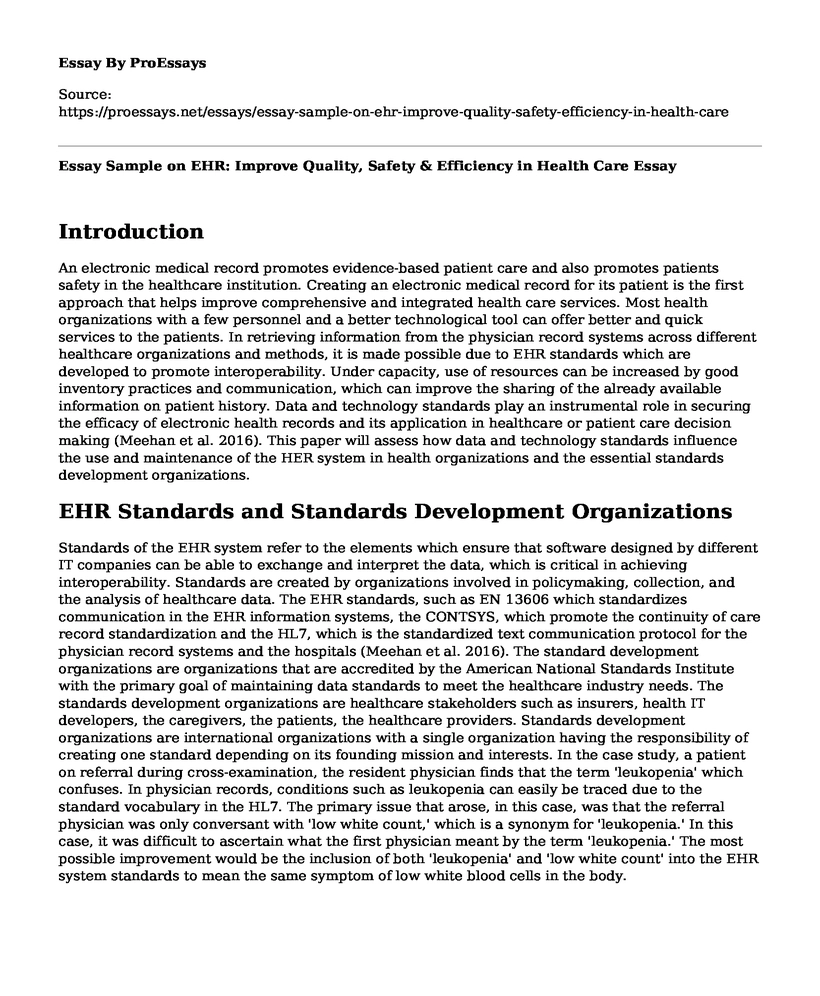Introduction
An electronic medical record promotes evidence-based patient care and also promotes patients safety in the healthcare institution. Creating an electronic medical record for its patient is the first approach that helps improve comprehensive and integrated health care services. Most health organizations with a few personnel and a better technological tool can offer better and quick services to the patients. In retrieving information from the physician record systems across different healthcare organizations and methods, it is made possible due to EHR standards which are developed to promote interoperability. Under capacity, use of resources can be increased by good inventory practices and communication, which can improve the sharing of the already available information on patient history. Data and technology standards play an instrumental role in securing the efficacy of electronic health records and its application in healthcare or patient care decision making (Meehan et al. 2016). This paper will assess how data and technology standards influence the use and maintenance of the HER system in health organizations and the essential standards development organizations.
EHR Standards and Standards Development Organizations
Standards of the EHR system refer to the elements which ensure that software designed by different IT companies can be able to exchange and interpret the data, which is critical in achieving interoperability. Standards are created by organizations involved in policymaking, collection, and the analysis of healthcare data. The EHR standards, such as EN 13606 which standardizes communication in the EHR information systems, the CONTSYS, which promote the continuity of care record standardization and the HL7, which is the standardized text communication protocol for the physician record systems and the hospitals (Meehan et al. 2016). The standard development organizations are organizations that are accredited by the American National Standards Institute with the primary goal of maintaining data standards to meet the healthcare industry needs. The standards development organizations are healthcare stakeholders such as insurers, health IT developers, the caregivers, the patients, the healthcare providers. Standards development organizations are international organizations with a single organization having the responsibility of creating one standard depending on its founding mission and interests. In the case study, a patient on referral during cross-examination, the resident physician finds that the term 'leukopenia' which confuses. In physician records, conditions such as leukopenia can easily be traced due to the standard vocabulary in the HL7. The primary issue that arose, in this case, was that the referral physician was only conversant with 'low white count,' which is a synonym for 'leukopenia.' In this case, it was difficult to ascertain what the first physician meant by the term 'leukopenia.' The most possible improvement would be the inclusion of both 'leukopenia' and 'low white count' into the EHR system standards to mean the same symptom of low white blood cells in the body.
Types of Data vs. Data Formats vs. Data Reporting Requirements
There are varied types of data that are designed for serving different purposes in the healthcare systems. Big data is a vital type of data systems that are created by human beings, and it is well utilized in hospitals. Big data systems help in the storage of vast information of patients and aid in creating well-integrated information. The EHRs rely heavily on the data sets to aid in illustrating the knowledge of patients, and this helps in the right interpretation of the data of patients. Bid data is subdivided into uninstructed, structured, and semi-structured systems that aid in the understanding of information more reliably. Big data is more extensive, thus cannot get to be classified under the standardized databases (National Institutes of Health. 2006). The machines and human beings remain to be the critical impacts of the creation of robust data systems for Electronic Health Records Systems apprehension.
The data formats help in the integration of the information in a more comprehensive means in the healthcare systems. Most hospital firms prefer the variance of data formats for illustrating the information of data in more capable ways. The big data is more contemporary for use in the healthcare systems, and thus it is suitable for companies to adopt big data. Big data is illustrated in the form of interpreting data for the people to get more understanding and adaptable to it. The complexity form of education of the different personnel is well established and provided for by the creating of a good platform for personality traits (National Institutes of Health. 2006). The role of integrating the information between the health status and the data of patients through the use of data systems is very vital for healthcare professionals.
References
Meehan, R. A., Mon, D. T., Kelly, K. M., Rocca, M., Dickinson, G., Ritter, J., & Johnson, C. M. (2016). Increasing EHR system usability through standards: Conformance criteria in the HL7 EHR-system functional model. Journal of biomedical informatics, 63, 169-173. Retrieved from https://www.sciencedirect.com/science/article/pii/S1532046416300971
National Institutes of Health. (2006). Electronic health records overview. National Center for Research Resources. National Institutes of Health, Bethesda. Retrieved from https://s3.amazonaws.com/rdcms-himss/files/production/public/HIMSSorg/Content/files/Code%20180%20MITRE%20Key%20Components%20of%20an%20EHR.pdf
Cite this page
Essay Sample on EHR: Improve Quality, Safety & Efficiency in Health Care. (2023, Apr 04). Retrieved from https://proessays.net/essays/essay-sample-on-ehr-improve-quality-safety-efficiency-in-health-care
If you are the original author of this essay and no longer wish to have it published on the ProEssays website, please click below to request its removal:
- Vestibular Rehabilitation Essay
- Caring for Client With Burn Injuries Essay
- Effects Of Temperature And Culture On Medium
- Stress and Burnout Lead to Bullying in Nursing Essay Example
- Data-Driven Decision Making: Incorporating the Evidence Paper Example
- Paper Example on IAD: Causes, Signs, and Prevention of Incontinence-Associated Dermatitis
- Essay Sample on Parkinson's: An Overview of Symptoms & Causes







